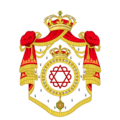Monarchy of Transcander: Difference between revisions
mNo edit summary |
m (1 revision imported) |
(No difference)
| |
Latest revision as of 16:24, 20 March 2019
This article is incomplete because it is pending further input from participants, or it is a work-in-progress by one author. Please comment on this article's talk page to share your input, comments and questions. Note: To contribute to this article, you may need to seek help from the author(s) of this page. |
| Prince of Transcandar | |
|---|---|
| [Çandaröte Bey] Error: {{Lang}}: text has italic markup (help) | |
 | |
| Incumbent | |
| <imgur w="180">j93kL7q.jpg</imgur> | |
| Temür II since 30 April 2009 | |
| Details | |
| Style | His Majesty |
| Heir apparent | Şahnur Valihatun, Princess of Kastamonu |
| First monarch | Atakhan the Elder |
| Formation | c. 1100 |
| Residence | Yıldız Palace |
The Monarchy of Transcandar, colloquially known as the Transcandar Monarchy, is the Federal absolute monarchy of Transcandar. The Monarhcy is a hereditary position whose incumbent is styled Prince or Princess of Transcandar (Transcandarian: Çandaröte Bey/Hanım). The Prince also serves as the head-of-state and rules over the lower-princes and gentlemen of the various estates that form the government.
While the Transcandar monarchy is absolute, the monarch was never absolute in the sense that he wielded arbitrary power. The monarch still ruled under the law and could only legislate in agreement with the House of Peers of the Estates; rather, the absolutism introduced was the monarch's ability to run the government unfettered by the House of Representatives, contrary to earlier practice.
The current monarch is Temür II, who inherited the throne from his Father, Ozmen III, on the 30th April 2009 and was coronated a day after.